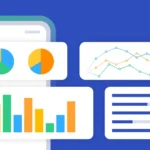In 2025, success in mobile app development is no longer defined solely by functionality or design. With more than 6 million apps spread across the App Store and Google Play, building an app is only the starting point. Real impact—and sustainable growth—come from how well that app performs and how easily users can discover it.
Mobile App Optimization (MAO) is the strategic process of refining both app performance and app store visibility. It combines user experience, performance diagnostics, and marketing intelligence to ensure your app stands out and scales efficiently.
This guide explores the top tools and methodologies defining mobile optimization today—and how they can help developers, marketers, and product teams gain competitive advantage.
What Is Mobile App Optimization?
Mobile App Optimization spans two interconnected disciplines:
- Performance Optimization: Enhancing how the app functions—reducing crashes, improving speed, streamlining navigation, and ensuring responsiveness across devices and networks.
- App Store Optimization (ASO): Increasing your app’s visibility and conversion rate within mobile app marketplaces using metadata improvements, keyword targeting, and A/B testing.
Together, these efforts drive better user satisfaction, higher retention, and more organic downloads.
Why Optimization is Mission-Critical in 2025
The mobile app ecosystem has matured, and so have user expectations. Here’s why mobile optimization is essential:
- App Store Competition: App marketplaces prioritize apps with higher ratings, lower crash rates, and better engagement.
- User Intolerance for Friction: Nearly 80% of users abandon an app after one use due to performance or usability issues.
- Data-Driven Growth: Businesses that integrate optimization tools into product development cycles report faster iteration and higher ROI.
Whether you’re launching a fintech app, a gaming platform, or a healthcare tool, optimization now plays a central role in product success.
Leading Tools for Mobile Performance Optimization
1. Firebase Performance Monitoring
Firebase, a Google-backed platform, offers real-time insight into app speed, responsiveness, and backend performance. It monitors slow app starts, network latency, and device-specific issues.
Why it’s valuable:
- Deep integration with Android
- Real-time alerts on performance drops
- Tracks metrics across geographies and device types
2. Instabug
Instabug captures crash reports, bugs, and user feedback directly from within the app experience. Its SDK makes it easy for developers to receive actionable diagnostics without disrupting users.
Best features:
- User-initiated bug reporting with screenshots
- Real-time crash analytics
- Customizable in-app surveys
3. UXCam
UXCam specializes in user experience analytics, offering session recordings, gesture tracking, and UI heatmaps. It helps product teams visualize real user behavior and identify usability gaps.
Use cases:
- Onboarding optimization
- UI/UX redesign validation
- Session-level user flow analysis
4. VWO Mobile Testing Suite
VWO enables mobile A/B testing, letting product teams experiment with layouts, content, and flows without deploying code. Ideal for iterative optimization without release cycles.
Why it’s effective:
- Code-free experiment setup
- Behavioral segmentation
- In-app personalization support
Top Tools for App Store Optimization (ASO)
Even the most performant app needs visibility. These tools focus on improving your app’s ranking, download rate, and market share in the app stores.
1. AppTweak
A go-to ASO solution for growth marketers, AppTweak offers keyword tracking, metadata suggestions, and competitor benchmarking across iOS and Android.
Standout features:
- Localized keyword analysis
- Category performance dashboards
- Creative asset performance reports
2. Sensor Tower
Sensor Tower combines ASO with market intelligence, enabling teams to evaluate category trends, advertising effectiveness, and regional performance.
Ideal for:
- Competitive research
- Growth opportunity discovery
- Portfolio-level performance tracking
3. MobileAction
MobileAction delivers a comprehensive platform for ASO, paid UA analytics, and creative testing. Its all-in-one dashboard makes it suitable for both indie developers and enterprise teams.
Core value:
- Real-time keyword visibility alerts
- Campaign-level performance insights
- Integrated ad intelligence
4. App Radar
Tailored for lean teams, App Radar simplifies app metadata management and keyword tracking with automation features and direct publishing integrations.
Why it stands out:
- Direct App Store & Google Play integration
- Store visibility scoring
- Alert-based keyword movement tracking
5. SplitMetrics Optimize
SplitMetrics helps marketers A/B test app store elements such as icons, titles, and screenshots. These experiments run outside the app store ecosystem, allowing controlled, data-driven creative decisions.
Best for:
- Improving conversion rates
- Lowering acquisition costs
- Market testing across geographies
Strategic Best Practices for MAO
Choosing the right tools is only part of the equation. Execution, consistency, and alignment with user needs determine whether your optimization efforts will yield long-term value.
1. Define the Right Metrics
Focus on KPIs that reflect real performance:
- Time to first interaction
- Retention rates (Day 1, Day 7, Day 30)
- Crash-free sessions %
- Store listing conversion rates
2. Localize Your ASO
Different markets require localized strategies. Translate not just language, but context—keywords, descriptions, and visuals should align with cultural expectations.
3. Test Early and Often
Whether it’s performance under high server load or conversion rates on different listing assets, continuous experimentation improves long-term agility.
4. Bridge Product and Marketing
Optimization is a cross-functional effort. Product, engineering, and growth teams must align on goals, tools, and execution timelines.
5. Competitor Intelligence
Monitor your category leaders. Use tools like Sensor Tower or MobileAction to track their changes in keywords, creatives, and review trends.
Matching Tools to Organizational Maturity
| Business Stage | Recommended Focus | Ideal Tools |
| Startup / MVP Phase | Speed, crash monitoring, early ASO | Firebase, App Radar, Instabug |
| Growth Stage | A/B testing, localization, UX insights | VWO, UXCam, AppTweak |
| Enterprise | Full-suite optimization, market intelligence, automation | Sensor Tower, MobileAction, SplitMetrics |
Selecting the right mix depends on your team size, budget, technical needs, and market goals. Avoid tool overload—opt for platforms that align with your highest-priority challenges.
Future Trends in Mobile App Optimization
Looking ahead, mobile optimization is entering a new era defined by intelligence, automation, and hyper-personalization.
- AI-Driven ASO: Machine learning models will suggest keyword updates, visual changes, and store timing based on performance history.
- Predictive UX Monitoring: Tools will flag potential user friction before it results in churn, enabling preventive design updates.
- Privacy-First Optimization: As regulations tighten, tools will adapt to provide insights without compromising user privacy—via federated learning or anonymized event streams.
Final Thoughts
In 2025, mobile app optimization is not a post-launch activity—it is a continuous, proactive discipline that blends engineering, marketing, and product strategy.
With the right tools, businesses can ensure their apps are not only functional but exceptional—delivering consistent performance, scalable user growth, and measurable impact.
Whether you’re refining an MVP or scaling a global platform, mobile app optimization is your foundation for long-term success. Invest in the right stack, test relentlessly, and make optimization a shared responsibility across your team.



